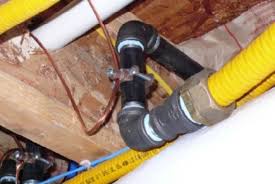-
Welcome to The Building Code Forum
Your premier resource for building code knowledge.
This forum remains free to the public thanks to the generous support of our Sawhorse Members and Corporate Sponsors. Their contributions help keep this community thriving and accessible.
Want enhanced access to expert discussions and exclusive features? Learn more about the benefits here.
Ready to upgrade? Log in and upgrade now.
You are using an out of date browser. It may not display this or other websites correctly.
You should upgrade or use an alternative browser.
You should upgrade or use an alternative browser.
CSST gas line bonding?
- Thread starter SCBO1
- Start date
FLSTF01
REGISTERED
Yes, either way is acceptable.
jar546
CBO

Would this bonding be allowed on a CSST gas line. The bounding wire is on the steel gas pipe and not on the brass fitting connector?
Some clamps are rated for use on pipes and others on rebar. I am not aware of any clamps that are listed and labeled to be used on the nut of CSST or any part of the CSST where the metal is exposed. Yes, that is good.
north star
MODERATOR
- Joined
- Oct 19, 2009
- Messages
- 4,596
% ~ %
Has that I-Joist been damaged ?.........The opening in the web
appears to be too large.
% ~ %
Has that I-Joist been damaged ?.........The opening in the web
appears to be too large.
% ~ %
No.Require a test of the ground?
Solid #6 attached upstream of the CSST and taken to the grounding electrode system.
There is a CSST manufacturer that makes the claim that their CSST has been Listed without the bonding jumper. I haven't seen the Listing so I don't know for sure.
When this material came on the market a certification was required to install or inspect it. That has changed up to "anybody can do both". Sometimes I ask for the installation instructions.....they discover a forty page document.....with striker plates......and change to hard pipe.
Last edited:
No.
Solid #6 attached upstream of the CSST and taken to the grounding electrode system.
There is a CSST manufacturer that makes the claim that their CSST has been Listed without the addition bonding jumper. I haven't seen the Listing so I don't know for sure.
When this material came on the market a certification was required to install or inspect it. That has changed up to "anybody can do both". Sometimes I ask for the installation instructions.....they discover a forty page document.....with striker plates......and change to hard pipe.
I think it is the black csst, May have a continuous ground, through the length of the pipe
I think it is the black csst, May have a continuous ground, through the length of the pipe
Yes, cda, there is a black type CSST with internal grounding made by OmegaFlex called TracPipe-Counter Strike that I see used around this area and not requiring bonding. I was aware that on the yellow CSST (Gastite) type piping that you can not attach the bonding to the yellow jacket and thought it had to be connected to the brass fitting. I get a lot of push back because it's hard to find a connecting clap that can be used on the CSST brass connector so they tend to fasten to the steel pipe.
Gastite instructions show a large clamp but sez you can install the bonding wire to a segment of rigid steel pipe. The bonding conductor shall be no smaller than a #6 copper wire and I'm seeing green jacket braided copper bonding wire instead of solid. Information Source: Gastite Technical Bulletin #TB2010-01
steveray
SAWHORSE
When some entity decides to list a clamp for a particular type of material what is the criteria they use?
Money
Inspector Gift
SAWHORSE
Watch the YouTube video from a CSST Manufacture on the Installation of Bonding Clamps:
How to Properly Bond HOME-FLEX CSST
And read the comments from an inspector regarding clamping:
https://activerain.com/blogsview/4602662/bonding-csst-gas-line-in-omaha--nebraska
(I particularly appreciated his story on the importance of sleeving the CSST where it passes thru the sidewalls of Fireplace Inserts.)
How to Properly Bond HOME-FLEX CSST
And read the comments from an inspector regarding clamping:
https://activerain.com/blogsview/4602662/bonding-csst-gas-line-in-omaha--nebraska
(I particularly appreciated his story on the importance of sleeving the CSST where it passes thru the sidewalls of Fireplace Inserts.)
(I particularly appreciated his story on the importance of sleeving the CSST where it passes thru the sidewalls of Fireplace Inserts.)
IG, I'm seeing that here on fireplaces.
steveray
SAWHORSE
I believe someone had a listed bonding clamp for the CSST fittings...It was like $47.....
Apparently there is no technical criteria for listing a clamp. This lack of criteria suggests that there is no rational basis for requiring clamps be listed. So why is a listing being required.
If you are concerned about bonding thein you could resolve the question by measuring the resistance. There will always be some resistance so you cannot say zero.. The question is what is an acceptable value?
If you are concerned about bonding thein you could resolve the question by measuring the resistance. There will always be some resistance so you cannot say zero.. The question is what is an acceptable value?
jar546
CBO
Apparently there is no technical criteria for listing a clamp. This lack of criteria suggests that there is no rational basis for requiring clamps be listed. So why is a listing being required.
If you are concerned about bonding thein you could resolve the question by measuring the resistance. There will always be some resistance so you cannot say zero.. The question is what is an acceptable value?
Maybe you could start with UL467
